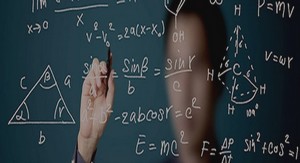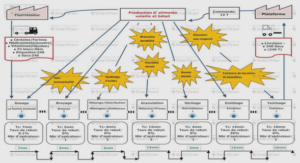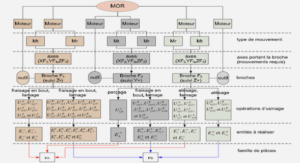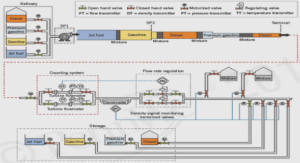Cours an introduction to combinatorial hopf algebras and renormalisation, tutoriel & guide de travaux pratiques en pdf.
Rings and fields.
Definition 1.2.1.
A ring is a triple (R, +, ·) where:
- (R, +) is an abelian (i.e. commutative) group, with unit element denoted by 0.
- (R, ·) is a monoid, with unit element denoted by 1.
The following distributivity property holds for any x, y, z ∈ R: x(y + z)= xy + xz (left distributivity),
(x + y)z = xz + yz (right distributivity).
Note that the left and right distributivity properties are respectively equivalent to the commutativity of the two following diagrams, with s(x, y) := x + y, m(x, y) := xy and τ23 := IdR ×τ × IdR.
In particular, 0 is an absorbing element in a ring: for any x ∈ R we have: x.0 = x.(1 − 1) = x.1 − x.1 = x − x = 0.
A commutative ring is defined the same way, except that the commutativity assumption for the product · is added. Left and right distributivity properties coincinde in that case.
Remark 1.2.1.
Unless specified, we always consider unital rings. Non-unital rings R, where (R, .) is only a semigroup and not necessarily a monoid, will be considered in Paragraph 2.1.
We stick to commutative rings for the moment. A divisor of zero is an element x = 0 such that there exists y = 0 with xy = 0. A commutative ring without divisors of zero is an integral domain.
Example 1.2.1
The set Z = {. . . , −2, −1, 0, 1, 2, . . .} endowed with usual addition and mul-tiplication is an integral domain.
Example 1.2.2.
Let R be a commutative ring. The ring R[X] of polynomials in one indeter-minate with coefficients in R is defined as:
R[X] := rj Xj , rj ∈ R, rj = 0 for j >>+∞ j=0
The addition is performed termwise: for any P = j≥0 rj Xj and Q = j≥0 sj Xj in R[X], one has:
P + Q := (rj + sj )Xj . j≥0
The product is determined by the rule XiXj = Xi+j extended by the distributivity relation.
Explicitly: P Q =rasb Xj . j≥0 a,b≥0, a+b=j
The degree of the polynomial P is given by deg P := sup{j ≥ 0, rj = 0}, and the valuation of the polynomial P is given by val P := inf{j ≥ 0, rj = 0}.
DOMINIQUE MANCHON
A monomial is a polynomial P such that deg P = val P . It is given by P = rXj for some ∈ R − {0} and j ≥ 0.
Example 1.2.3.
Let R be a commutative ring. The ring R[[X]] of formal series in one indeterminate with coefficients in R is defined as:
R[[X]] := rj Xj , rj ∈ R j=0
without any other condition on the coefficients. The sum and product are defined the same way as for polynomials. The notion of degree does not make sense anymore, but the notion of valuation still does.
Definition 1.2.2.
An ideal in a commutative ring R is a nonempty subset J ⊆ R such that xy ∈ J for any x ∈ R and y ∈ J. In short, RJ⊆J.
If the ring R is not commutative, one distinguishes between left ideals, right ideals and two-sided ideals, respectively characterized by the properties RJ⊆J, JR⊆J, RJ∪JR⊆J.
The intersection of two left ideals is a left ideal. The same holds for right ideals and two-sided ideals.
Definition 1.2.3.
A field is a commutative ring K which has no ideal except {0} and K.
Proposition 1.2.1.
Any nonzero element in a field is invertible.
Proof
Let a ∈ K − {0}, and let J be the smallest ideal (for the inclusion) containing a. We have J = K by definition of a field. In particular 1 ∈ J, hence there exists b ∈ K such that ab = 1.
Examples of fields:
- the field Q of rational numbers,
- number fields, i.e. finite extensions of Q,
- the field R of real numbers,
- the field C of complex numbers,
- the field K(X) of rational fractions over a given field K,
- the field K[X−1, X]] of Laurent series over a given field K, i.e k[X−1,X]] = aj Xj , aj ∈ K, aj = 0 forj∈Z
- The field Qp of p-adic numbers, p being a prime number,
- The finite field Fp = Z/pZ, p being a prime number.
Definition 1.2.4. Let K be a field. Its characteristic is the smallest nonzero number p such that, for any a ∈ K, pa := a + · · · + a = 0. If such a p does not exist, the field K is of time characteristic zero.
The characteristic of a field is always zero or a prime number.
Modules over a ring.
Definition 1.3.1.
A module over a commutative ring R is an abelian group (M, +) together with a binary product
m : R × M (λ, x) −→ → Mλx
such that:
- 0x = 0M for any x ∈ M,
- 1x = x for any x ∈ M,
- λ(µx) = (λµ)x for any x ∈ M and λ, µ ∈ R,
- λ(x − y) = λx − λy for any λ ∈ R and x, y ∈
The term vector space is used for modules over a field. Over a noncommutative ring R, one has to distinguish between left R-modules and right R-modules.
Linear algebra
. Let K be a field, and let V be a K-vector space. Let us recall that a subset ⊂ V is free if, for any (x1, . . . , xp) ∈ F p and any (λ1, . . . , λp) ∈ Kp, if λ1x1 + · · · + λpxp = 0 then λ1 = · · · = λp = 0. On the other hand, a subset F ⊂ V generates V if any element of V can be written as a linear combination λ1x1 + · · · + λnxn of elements xj ∈ F , with coefficients λj ∈ K. A basis is a subset which is both free and generating. In this case, any element of V can be written as a linear combination of elements of F in a unique way. Recall that all bases have the same cardinality: the dimension of the vector space V .
Proposition 1.4.1.
Any vector space admits a basis
Proof.
(sketch) This is a consequence of the axiom of choice: any free subset can be completed in order to form a basis.
Definition 1.4.1.
Let V and W be two vector spaces over the same field K. A morphism of K-vector spaces ϕ:V −→W. is called a linear map. In other words, a linear map ϕ is a morphism of abelian groups which moreover commutes with multiplication by scalars, i.e. ϕ(λx + µy) = λϕ(x) + µϕ(y) for any λ, µ ∈ K and any x, y ∈ V.
Introduction
1. Preliminaries
1.1. Semigroups, monoids and groups
1.2. Rings and fields
1.3. Modules over a ring
1.4. Linear algebra
1.5. Tensor product
1.6. Duality
1.7. Graded vector spaces
1.8. Filtrations and the functor Gr
Exercices for Section 1
2. Hopf algebras: an elementary introduction
2.1. Algebras and modules
2.2. Coalgebras and comodules
2.3. Convolution product
2.4. Intermezzo: Lie algebras
2.5. Bialgebras and Hopf algebras
Exercises for Section 2
3. Gradings, filtrations, connectedness
3.1. Connected graded bialgebras
3.2. Connected filtered bialgebras
3.3. Characters and infinitesimal characters
Exercises for Section 3
4. Examples of graded bialgebras
4.1. The Hopf algebra of rooted forests
4.2. Shuffle and quasi-shuffle Hopf algebras
4.3. Incidence Hopf algebras
4.4. The extraction-contraction forest bialgebra
Exercises for Section 4
5. Birkhoff decomposition and renormalisation
5.1. Birkhoff decomposition
5.2. A short account of renormalisation in physics
5.3. Renormalisation from Birkhoff decomposition
Exercises for Section 5
6. Comodule-bialgebras
6.1. Definition
6.2. The comodule-Hopf algebra structure on the rooted forests
Exercises for Section 6
7. Regularity structures
7.1. Coloured forests
7.2. Contractions
7.3. The Chu-Vandermonde identity
7.4. Playing with decorations
7.5. Decorations and contractions
References





